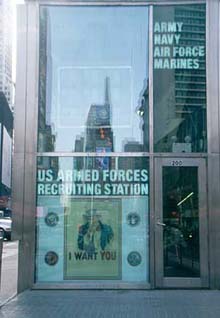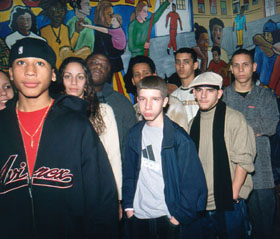|
Back to On the Road with John
Tarleton
Brooklyn Students Buck Military
By John Tarleton
The military’s individually targeted appeal to Reyes hasn’t worked to date. He still hopes to start college next fall at Hofstra University. However, the high pressure recruiting experienced by Reyes and many of his friends suggests what lies ahead for students as the military aggressively makes use of a little-known provision in the 670-page No Child Left Behind Act of 2002. The provision in the much-touted education bill requires high schools to military recruiters access to facilities as well as contact information for every student — or lose their federal aid. "The military would choose to be in every school in every classroom in every community if they could, because overkill is their way of doing things," says Rick Jahnkow, Director of Project YANO (Youth And Non-military Opportunities), a San Diego-based group founded in 1984.
No Child UnrecruitedThe military currently enlists 350,000 people a year. Its recruitment efforts have become increasingly sophisticated, and relentless, since it switched from the draft to an all-volunteer force in 1973 at the end of the Vietnam War. It spends hundreds of millions of dollars to advertise on television, radio, web sites, outdoor ads, and in youth publications. It also operates Junior Reserve Officer Training Corps (JROTC) programs in 3,500 schools, holds summer camp programs on military bases for disadvantaged youth, and provides guidance counseling, after-school tutoring and dropout recovery programs in some troubled inner city schools. Mobile recruiting stations also appear in shopping malls, at sporting events and inside theaters at showings of popular pro-military movies. In Bushwick, getting the message out also means calling prospective recruits as early as 6 a.m. and showing up at their workplaces and outside of their churches, according to Reyes and Jesus Gonzalez, 17, a junior at Bushwick Outreach. Under the No Child Left Behind Act, students or their parents can sign an opt-out form to prevent information from being released. In late September, the city’s Department of Education mailed the forms to parents of over a quarter million high school students, giving them an Oct. 15 reply deadline. Reyes says most Bushwick Outreach students were unaware of the forms and were barraged by recruiter appeals soon after the deadline passed. The students’ frustration at their loss of privacy boiled over on Oct. 23 when about 60 of them held a protest in front of nearby Bushwick High School. They demanded a reversal of the opt-out form, which would allow their information to be released only with their permission. "It’s for us to decide if we want to give them information," says Gonzalez, who along with Reyes is also an organizer for the Youth Power project of Make the Road by Walking, a Bushwick-based community organization. "If we want to sign up, we can walk down to the recruiting station on Myrtle Avenue."
Unrealized Dreams
"It’s clear what the high people in the Navy and the military think about people of color in poor neighborhoods," Gonzalez says. Captain John Caldwell, public affairs officer for the Marine Corps 1st Recruiting District, which encompasses New York City, says the military is simply trying to offer students another opportunity. "They get tons of information from colleges when they are looking at going to school," he says. "We’re also providing information that could help them get an education and a job." Yet these promises of education and training are misleading, critics say. The present-day GI Bill is fraught with loopholes and stringent conditions that cause many soldiers to lose their educational benefits. Most soldiers train on equipment that is obsolete or has no civilian counterpart, or they perform specific functions on one or two machines, leaving them with few real world skills. "Somebody who was a cook at McDonald’s who learns how to pick up a tray of prepared food, put in a heater, heat it up and wrap it, couldn’t walk in the door of a regular restaurant and say I want to be a chef," says John Judge, a longtime anti-recruitment activist based out of Washington, D.C.
”These Kids Want to Go to College.”The Bushwick action has since inspired other youth activists in the city. Youth Bloc, a citywide network of high school-age activists, has decided to launch a campaign against No Child Left Behind as well as JROTC, which is currently active in about 100 high schools across the city. The Youth Bloc activists plan to visit a high school a week in each borough except Staten Island, giving presentations or leafleting outside. "It’s our generation that’s going to be the cannon fodder," says Mike Gould-Wartoffky, a Youth Bloc member and senior at Hunter College High School. "We want our generation to be in the front lines of the anti-war movement, not the war." The Bushwick students look to hold more anti-recruitment actions, but say their first priority is having more options in life than Army, Navy Air Force or Marines. "Bring college recruiters, not military recruiters," Reyes says. "F— the military. These kids want to go to college." LINKS
American
Friends Service Committee Youth and Militarism
Project This article originally appeared in the New York Indypendent |
 NEW YORK--Luis Reyes is a senior at Bushwick Outreach
Center in Brooklyn who wants to study journalism in
college. He recently discovered that military
recruiters had the inside scoop on him.
"They know my interests and everything," says Reyes,
19. "I’m already getting all kinds of letters and
phone calls and whatnot."
NEW YORK--Luis Reyes is a senior at Bushwick Outreach
Center in Brooklyn who wants to study journalism in
college. He recently discovered that military
recruiters had the inside scoop on him.
"They know my interests and everything," says Reyes,
19. "I’m already getting all kinds of letters and
phone calls and whatnot."
 Commander Edward Gehrke, head of Navy recruiting in
New
York, poured more fuel on the fire by responding to
the protest in a letter to the New York Daily News,
stating that most Bushwick students were plagued by
police and drug problems and wouldn’t be eligible to
enlist if they tried.
Commander Edward Gehrke, head of Navy recruiting in
New
York, poured more fuel on the fire by responding to
the protest in a letter to the New York Daily News,
stating that most Bushwick students were plagued by
police and drug problems and wouldn’t be eligible to
enlist if they tried.